
Albany is the capital city of the U.S. state of New York and the seat of Albany County. It is located on the west bank of the Hudson River, about 10 miles (16 km) south of its confluence with the Mohawk River, and about 135 miles (220 km) north of New York City.

Lincoln Square on the North Side of Chicago, Illinois, is one of the city's 77 community areas. It encompasses the smaller neighborhoods of Ravenswood, Ravenswood Gardens, Bowmanville, Budlong Woods as well as Lincoln Square itself.
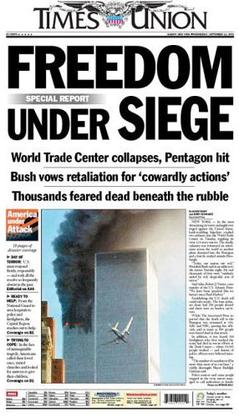
The Times Union, or Times-Union, is an American daily newspaper, serving the Capital Region of New York. Although the newspaper focuses on Albany and its suburbs, it covers all parts of the four-county area, including the cities of Troy, Schenectady and Saratoga Springs. In 2021, the paper also expanded to covering the Hudson Valley. It is owned by Hearst Communications. The paper was founded in 1856 as the Morning Times, becoming Times-Union by 1891, and was purchased by William Randolph Hearst in 1924. The sister paper Knickerbocker News merged with the Times Union in 1988. The newspaper has been online since 1996.
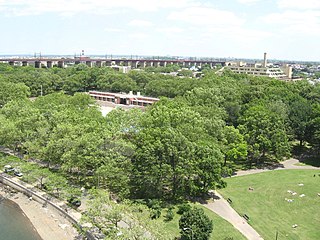
Astoria Park is a 59.96-acre (24.26 ha) public park in the Astoria neighborhood of Queens in New York City. The park is situated on the eastern shore of the Hell Gate, a strait of the East River, between Ditmars Boulevard to the north and Hoyt Avenue to the south. The Robert F. Kennedy (Triborough) and Hell Gate Bridges respectively pass over the park's southern and northern sections. Astoria Park contains a playground, a soccer field, a running track, a skate park, and courts for tennis, basketball, and bocce. Astoria Park also includes the Astoria Play Center, which consists of a recreation center and a pool. The park and play center are maintained by the New York City Department of Parks and Recreation.

The neighborhoods of Albany, New York are listed below.
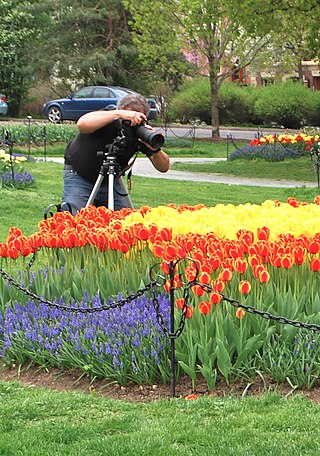
Washington Park in Albany, New York is the city's premier park and the site of many festivals and gatherings. As public property it dates back to the city charter in 1686, and has seen many uses including that of gunpowder storage, square/parade grounds, and cemetery. The park is often mistaken as being designed by Frederick Law Olmsted, as it incorporate many of the philosophical ideals used by Olmsted when he designed Central Park in Manhattan. The park is about 81 acres (33 ha) in size with the 5.2-acre (2.1 ha) Washington Park Lake, a roughly 1,600-foot-long (490 m) and 140-foot-wide (43 m) lake, in the southwestern corner.

There are 75 properties listed on the National Register of Historic Places in Albany, New York, United States. Six are additionally designated as National Historic Landmarks (NHLs), the most of any city in the state after New York City. Another 14 are historic districts, for which 20 of the listings are also contributing properties. Two properties, both buildings, that had been listed in the past but have since been demolished have been delisted; one building that is also no longer extant remains listed.


The Albany Convention Center (ACC) was a proposed convention center to be located in downtown Albany, New York. The complex was initially proposed by Albany Mayor Gerald Jennings in 1994. In 2004, the Albany Convention Center Authority (ACCA) was established by the New York Legislature as a New York State public-benefit corporation to develop plans for the ACC. Supported by Governor George Pataki, the project was awarded a $75 million grant in 2006. The anticipated price tag of the project was approximately $220 million, and a site between Broadway, Hudson Avenue, and the South Mall Arterial was selected. In 2008, 2009, and 2010, the ACCA acquired much of the property that made up the proposed site.

Downtown Schenectady is the central business district for the city of Schenectady, New York. It originated in the 1820s with the moving of the commercial and industrial interests east from the original 17th and 18th century settlement, spurred on by the development of the Erie Canal. Home to the headquarters and major manufacturing plants of two large corporations, General Electric and American Locomotive Company, Downtown Schenectady catered to tens of thousands of workers in its heyday. Typical of the post-industrial Northeastern United States and Upstate New York in particular, Downtown Schenectady saw a decline in manufacturing and population starting in the 1970s. Recent construction and renovation has caused the downtown area to become an entertainment mecca for New York's Capital District anchored by Proctor's Theatre.
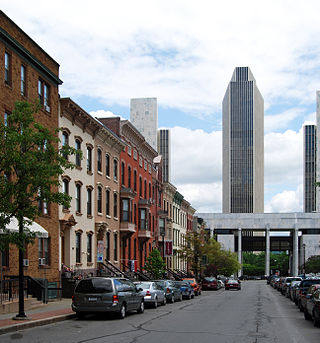
The architecture of Albany, New York, embraces a variety of architectural styles ranging from the early 18th century to the present. The city's roots date from the early 17th century and few buildings survive from that era or from the 18th and early 19th century. The completion of the Erie Canal in 1825 triggered a building boom, which continued until the Great Depression and the suburbanization of the area afterward. This accounts for much of the construction in the city's urban core along the Hudson River. Since then most construction has been largely residential, as the city spread out to its current boundaries, although there have been some large government building complexes in the modernist style, such as Empire State Plaza, which includes the Erastus Corning Tower, the tallest building in New York outside of New York City.

North Albany is a neighborhood in the city of Albany, New York. North Albany was settled in the mid-17th century by the Patroon of Rensselaerswyck and his tenants and later became a hamlet in the town of Watervliet. Due to the Erie Canal being constructed in 1825, North Albany saw immense growth, with the Albany Lumber District and an influx of Irish immigrants lending the area the name of Limerick. Home to many historic warehouses and row houses, North Albany continues to be an important industrial neighborhood. Recent efforts have begun to gentrify the neighborhood by adapting heavy industry/warehouse use to artistic and entertainment venues, such as a German beer garden, an amusement park, live music venues, and arts and crafts marketplaces.
Pine Hills is a neighborhood in Albany, New York, generally defined as the area from Manning Boulevard to the west, Woodlawn Avenue to the south, Lake Avenue to the east, and Washington Avenue to the north. The neighborhood consists mainly of freestanding multi-unit, duplex, and semi-detached houses and is home to Albany High School, the LaSalle school, the College of St. Rose, and the Alumni Quad of the University at Albany. Though mostly residential due to historical reasons from its founding, Pine Hills is home to two neighborhood commercial districts ; Middle Madison, from Partridge to Quail streets was designated first, and then a latter designated district, Upper Madison, from Main Avenue to North Allen Street. The area of Pine Hills east of Main Avenue and north of Myrtle Avenue is commonly referred to as the student ghetto due to its predominant population of college-age students. The area of Pine Hills west of Main Avenue features many large Queen Anne, Folk Victorian, and Colonial Revival homes. Upper Madison, where it meets Western Avenue near St. Rose is the center of a commercial area, complete with a movie theater, grocery store, fast food strip mall, retail, restaurants, a library, community playhouse, police station, pharmacy, and elementary school.

Sheridan Hollow is a neighborhood in Albany, New York located in a ravine north of Downtown Albany. Capitol Hill to the south and Arbor Hill to the north flank the ravine. Often the neighborhood is overlooked by city residents, and outsiders who work in the neighborhood often don't recognize the name of the neighborhood. This is due to the identity of the Hollow being subsumed into its larger neighbor Arbor Hill, for instance news stories of events are often accredited to the wrong neighborhood. Being on undesirable land for development in colonial times, growth was slow in the Hollow and the neighborhood was populated through the centuries by a series of ethnic groups new to Albany, such as the Irish, Polish, and African Americans.
The Tivoli Nature Preserve, also Tivoli Park, in Albany is the largest urban nature preserve in the Capital District.

Townsend Park is a small urban park in Albany, New York. It encompasses a triangle of land formed by the Y-intersection of Central and Washington avenues, with the third (western) border formed by Henry Johnson Boulevard.

Dana Park is a small .2-acre (810 m2) urban park in Albany, New York and includes a memorial to James Dana which doubles as Albany's last remaining horse trough. It is located in the Y-intersection caused by Delaware Avenue to the east and Lark Street to the west, with the third leg of the triangle formed by Dana Avenue. Madison Avenue forms a five-point intersection with Lark Street and Delaware Avenue at the eastern end of the park. The park is important to several different neighborhoods, Hudson-Park, Park South, and Lark Street.

Bleecker Park is a small .37-acre (0.15 ha) urban park in Albany, New York. The park is triangle-shaped, bounded by Madison Place to the south, Madison Avenue to the north, and Eagle Street to the west. The Cathedral of Immaculate Conception is across Eagle Street from the park, while Madison Place, which is only one block-long, consists of rowhouses primarily in High Gothic and Italianate architecture, built in the mid-to-late-19th century. Across from the park on Madison Street is the Empire State Plaza East Parking Garage, built in 1999/2000. The park features the oldest fountain in the city which is surrounded by a small circular garden, two circular beds are also in the park and each feature a shrub surrounded flowers, these small gardens make Bleecker Park "a most charming and restrained Victorian public garden" according to an article in the Albany Times Union.
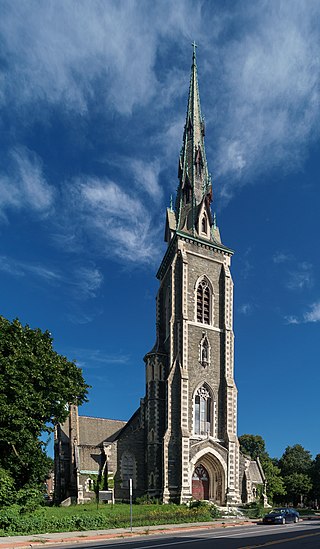
St. Joseph's Church is a historic neo-gothic church edifice in the Ten Broeck Triangle section of Albany, New York's Arbor Hill neighborhood. The structure is considered a city landmark and an important part of the Albany skyline. The church closed in 1994. The City of Albany placed the church for sale in February 2023.

Jackie Robinson Park is a public park in the Hamilton Heights and Harlem neighborhoods of Manhattan in New York City. The approximately 12.77-acre (5.17 ha) park is bounded by Bradhurst Avenue to the east, 155th Street to the north, Edgecombe Avenue to the west, and 145th Street to the south. The park has baseball fields, basketball courts, restrooms, and a bandshell, which are arranged around the park's steep terrain. It also includes the Jackie Robinson Play Center, which consists of a recreation center and a pool. Jackie Robinson Park is maintained by the New York City Department of Parks and Recreation.
























